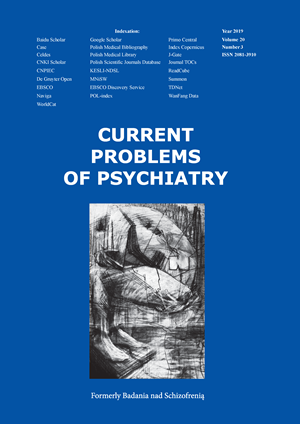Wpływ treningu metakognitywnego na poprawę pamięci operacyjnej u dzieci z ADHD
DOI:
https://doi.org/10.2478/cpp-2019-0015Słowa kluczowe:
pamięć operacyjna, trening metakognitywny, ADHD, Mapy Myśli, SketchnotingAbstrakt
Celem badania jest sprawdzenie, czy pamięć operacyjna wzmocni się po trzymiesięcznym treningu metapoznawczym z użyciem takich mnemotechnik jak: Mapy Myśli i Notatka Rysunkowa u dzieci z diagnozą ADHD. W aktualnej klasyfikacji zaburzeń psychicznych DSM 5 przypisuje się kluczową rolę pamięci operacyjnej zarówno w objawach ADHD jak również wtórnie w problemach takich jak: zaburzenia uczenia się, trudnościach zawodowych czy społecznych.
Metoda. W badaniu eksperymentalnym wzięło udział 45 dzieci w wieku szkolnym (M= 10,41; SD=1,42). Każde dziecko posiadało zdiagnozowany zespół nadpobudliwości psychoruchowej z zaburzeniami uwagi. Uczestnicy zostali losowo zakwalifikowani do trzech grup: ze stymulacją Mapami Myśli, Notatką Rysunkową i do grupy kontrolnej. Wszyscy zostali zbadani Testem Odroczonego Nazywania przed i po treningu. Narzędzie to należy do Baterii Diagnozy Funkcji Poznawczych PU-1.
Wyniki. Pamięć operacyjna poprawiła się w każdej z trzech grup. Najmniej błędów popełniały dzieci będące w grupie z Mapami Myśli natomiast najwięcej błędów miały dzieci z grupy Kontrolnej.
Wniosek. Mapy Myśli mogą stanowić istotne uzupełnienie innych form pomocy terapeutycznych dla dzieci z diagnozą ADHD. Regularne stosowanie narzędzia w edukacji, czy terapii wzmacnia pamięć operacyjną. Poprawa tej funkcji wykonawczej może być znacząca w nauce pisania i czytania (zapamiętywanie prawidłowych kształtów liter), zapamiętywania i przywoływania z pamięci ustalonych z dzieckiem zasad, czy lepszej orientacji czasowej.
Bibliografia
1. Filippetti V., López, M. Las funciones ejecutivas en la clínica neuropsicológica infantil. Psicología desde el Caribe/Executive functions in clinical child neuropsychology, 2013; 30: 380-415.
2. Nigg, JT, Willcutt, EG., Doyle, A E., Sonuga-Barke, E J. Causal heterogeneity in attention-deficit/hyperactivity disorder: do we need neuropsychologically impaired subtypes? Biological Psychiatry, 2005; 57(11): 1224-30. https://doi.org/10.1016/j.biopsych.2004.08.025
3. Barkley, RA. Attention-deficit hyperactivity disorder. A handbook for diagnosis and treatment, 3rd edn. Guilford Press, New York, 2006.
4. Dovis, S, Maric, M, Prins, Pier JM, Oord, S. Does executive function capacity moderate the outcome of executive function training in children with ADHD? ADHD Attention Deficit and Hyperactivity Disorders, 2019; 1: 1-16. https://doi.org/10.1007/s12402-019-00308-
5. Barkley, RA. Attention-deficit hyperactivity disorder, fourth edition: A handbook for diagnosis and treatment. New York, NY: Guilford, 2014.
6. Barkley, RA. Impaired delayed responding: A unified theory of attention-deficit hyperactivity disorder. In D. K. Routh. Ed., Disruptive behavior disorders in childhood (pp. 11-57). New York, NY, US: Plenum Press, 1994. https://doi.org/10.1007/978-1-4899-1501-6_2
7. Yen CY., Ko CH., Yen CF., Wu HY., Yang MJ. The Comorbid Psychiatric Symptoms of Internet Addiction: Attention Deficit and Hyperactivity Disorder (ADHD), Depression, Social Phobia, and Hostility. Journal of Adolescent Health, 2007; 41(1): 93-98. https://doi.org/10.1016/j.jadohealth.2007.02.002
8. Klingberg T. Training and plasticity of working memory. Trends in Cognitive Sciences, 2010; 14: 317-324. https://doi.org/10.1016/j.tics.2010.05.002
9. Alderson RM,. Patros, CHG,. Tarle, SJ, Hudec, KL, Kasper, LJ, Lea, SE. Working memory and behavioral inhibition in boys with ADHD: An experimental examination of competing models, Child Neuropsychology, 2015; 1-18. https://doi.org/10.1080/09297049.2015.1105207
10. Entwistle PC., Shinaver C. Working Memory Training and Cogmed In: S. Goldstein, J. A. Naglier (Ed.), Handbook of Executive Functioning (pp. 475-498). London: Springer, 2014. https://doi.org/10.1007/978-1-4614-8106-5
11. American Psychiatric Association. Diagnostic and statistical manual of mental disorders (5th ed.). Arlington, VA: American Psychiatric Publishing, 2013.
12. Bigorra A., Garolera M., Guijarro S., Hervas A. Long-Term Far-Transfer Effects of Working Memory Training in Children with ADHD A Randomized controlled trial. European Child & Adolescent Psychiatry, 2016; 25(8):853-867. https://doi.org/10.1007/s00787-015-0804-3
13. Diamond A. Executive functions. Annual Review of Psychology, 2013; 64: 135–168. https://doi.org/10.1146/annurevpsych-113011-143750
14. Diamond A., Lee K. Interventions shown to Aid Executive Function Development in Children 4–12 Years Old, Science, 2011; 333(6045): 959-964. https://doi.org/10.1126/science.1204529.
15. Deja M. Trening uwagi u dzieci z ADHD – przegląd badań. Psychiatria i Psychologia Kliniczna, 2017; 17(1): 63-71. https://doi.org/10.15557/PiPK.2017.0007
16. Antshel KM., Hier BO., Barkley RA. Executive functions theory and ADHD In: S. Goldstein, J. A. Naglier (Ed.), Handbook of Executive Functioning (107-120). London: Springer, 2014. https://doi.org/10.1007/978-1-4614-8106-5
17. Meltzer L. Teaching Executive Functioning Processes: Promoting Metacognition, Strategy Use, and Effort, In: S. Goldstein, J. A. Naglier (Ed.), Handbook of Executive Functioning (pp. 445-474). London: Springer, 2014. https://doi.org/10.1007/978-1-4614-8106-5
18. Buzan T. Mind Mapping - kickstart your creativity and transform your life. BBC, London, 2009
19. Paivio, A. Dual coding theory and education. Draft chapter for the conference on “Pathways to Literacy Achievement for High Poverty Children,” The University of Michigan School of Education, September 29-October 1, 2006. Pozyskano 26.06.2019.
20. Balim AG. The Effect of Mind-Mapping Applications on Upper Primary Students' Success and Inquiry-Learning Skills in Science and Environment Education. International Research in Geographical and Environmental Education, 2013; 22(4): 337-352. https://doi.org/10.1080/10382046.2013.826543
21. Kajka N., Szymona K. Terapia ADHD: Trening sukcesu w pracy z dzieckiem nadpobudliwym. Lublin: Wyd. Czelej, 2014.
22. Sacks-Zimmerman AL., Lerma VC. Mnemonic Techniques. In: Kreutzer J.S., DeLuca J., Caplan B. (eds) Encyclopedia of Clinical Neuropsychology. Springer, Cham, 2018.
23. Perry K., Weimar H., Bell A. Sketchnoting in School: Discover the Benefits (and Fun) of Visual Note Taking. Lanham, Rowman & Littlefield Publishers, 2017.
24. Colombo B. Mental Imagery and Learning. In: Seel N.M. (Eds) Encyclopedia of the Sciences of Learning (pp.125-211). Springer, Boston, MA, 2012. https://doi.org/10.1007/978-1-4419-1428-6_68
25. Dahbi M. A Picture is Worth a Thousand Words Approach to Teaching English: Integrating Mind Maps. ELT Arab World English Journal (AWEJ), 2015; 6(1): 415-519. https://doi.org/10.24093/awej/vol6no1.32
26. Kajka N. Trudności w nauce czytania i pisania u dzieci z ADHD. Szkoła Specjalna, 2018; 3: 212-218.
27. Borkowska AR., Sajewicz-Radke U., Lipowska M., Kalka D. Bateria diagnozy funkcji poznawczych u dzieci w wieku 10-12 lat: PU1. Podręcznik. Gdańsk: PTPiP, 2016.
28. Sitnik-Wirchulska K., Izydorczyk B., Lipińska M. Wyzwania klinicznej diagnostyki psychologicznej dzieci i młodzieży. Rekomendacje konsultantów w dziedzinie psychologii klinicznej. Psychiatria i Psychologia Kliniczna, 2019; 19(1): 54-62. https://doi.org/10.15557/PiPK.2019.0008
29. Simmering VR, Wood CM. The development of real-time stability supports visual working memory performance: Young children's feature binding can be improved through perceptual structure. Developmental Psychobiology, 2017;53: 1474-1493. https://doi.org/10.1037/dev0000358
Pobrania
Opublikowane
Numer
Dział
Licencja
Prawa autorskie (c) 2019 Autor

Praca jest udostępniana na licencji Creative Commons Attribution-NonCommercial-NoDerivatives 3.0 Unported License.


